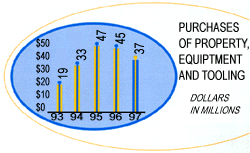Our strategy is to have the highest-quality, lowest-cost production capabilities in the industry, because that’s how superior value is created. By pushing quality up and costs down, we’re able to price each model competitively—and maintain margins so we can ride smoothly through market fluctuations. Key contributing factors are:
Diversified engine sources. Engines are the highest single cost component in our vehicles, so they represent our best opportunity for savings. By diversifying sources, we gain better control over margins and reduce the currency risk associated with imported engines. In 1997, we increased domestic engine production at our plant in Osceola, Wisconsin, and our joint venture plant with Fuji Heavy Industries in Hudson, Wisconsin. We plan to continue expanding production at both plants in 1998 and beyond.
 Supply management. While we work closely with our suppliers to improve quality and reduce costs, sometimes we find it’s more cost-effective to bring component production in-house. We’re currently building a plastic injection-molding facility adjacent to our Roseau, Minnesota assembly plant that will produce large, molded, plastic parts like sled hoods and ATV fenders starting in spring 1998. The $12 million investment will allow us to reduce costs and improve overall product quality.
Supply management. While we work closely with our suppliers to improve quality and reduce costs, sometimes we find it’s more cost-effective to bring component production in-house. We’re currently building a plastic injection-molding facility adjacent to our Roseau, Minnesota assembly plant that will produce large, molded, plastic parts like sled hoods and ATV fenders starting in spring 1998. The $12 million investment will allow us to reduce costs and improve overall product quality.
Rededicated quality effort. We refocused our efforts on quality in 1997 to reduce warranty costs. We completed the reorganization of our product lines into separate business units, which allows us to more quickly identify and solve issues. Quality starts with product development, where we consolidated some parts to minimize processes and gain more control. For example, we previously had numerous ATV chassis for our various models; now we make just three. And we will build Victory in modest quantities for the first two years to ensure we produce the industry’s premier bike.
| Cost-effective utilization of assets. We can quickly adjust to swings in demand because of our flexible manufacturing capabilities, which include common processes across all vehicles, employees trained to build all vehicles, and facilities that can be changed over in just one day. Compatibility with our existing systems is among the top criteria when we look at new product lines. | Our new plastic injection molding facility will bring component production in-house, allowing us to reduce overall costs and improve overall product quality. |
Highly productive, non-union, shareholder workforce. We have more sales per employee than our peer companies and most manufacturing companies. We feel it’s because nearly all Polaris employees, at every level, are shareholders. Profit-sharing for hourly employees averages about 40 percent of base pay, and two-thirds of executive compensation is based on company performance. Because Polaris employees have such a large stake in the company, everyone plays an active role in continuous improvement.